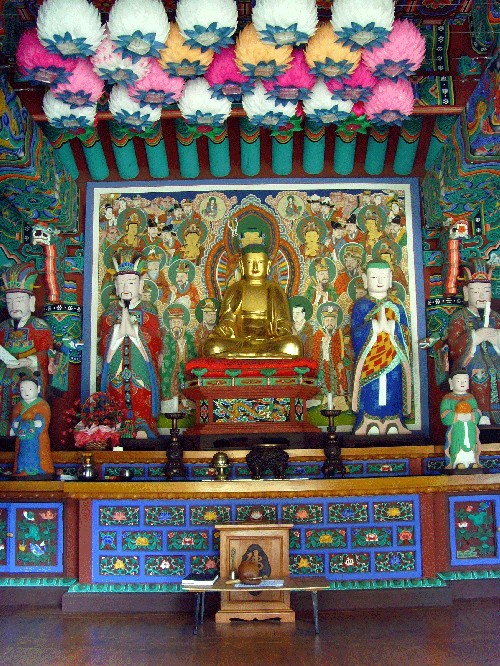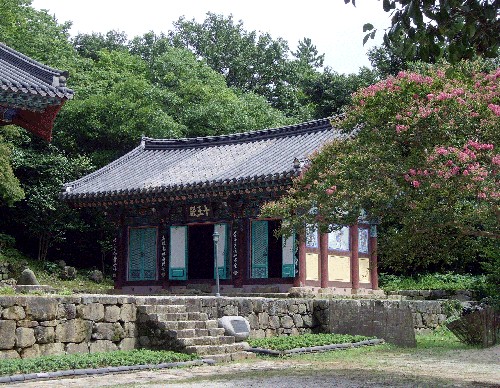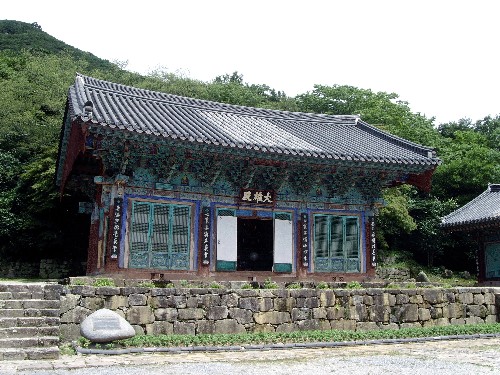사찰: 진도 쌍계사
Looking to the Inside, Jindo Ssanggyesa
By Gim Ye-seul, Student Editor
If traveling around Namdo, you will recognize that Buddhist temples are one of the finest representatives of cultural heritage in this region. You will probably have difficulty finding only one proper Buddhist temple that is worth visiting. You may select it based on the following standards: the temple is not widely known but has historical records and cultural heritage. Jindo Ssanggyesa would be the optimum choice. Ssanggyesa, which is located on the western foot of

When this reporter arrived at Jindo, the weather was so nice contrary to the weather forecast. On my way to Ssanggyesa, a kind bus driver told me several interesting stories connected with places, including the legend of the grave of Wangon, a general who fought against the Mongolian army. Ssanggyesa is located between two valleys in a dense evergreen forest designated as a precious natural treasure. A path through the forest to the temple was awesome. A stream running beside the path was so clear that I could see its bottom and small fish. Fresh green leaves, light reflecting from the stream, and bird's chirpings looked like a picture scroll had been spread out.
Looking Around Ssanggyesa
After crossing the gate, this reporter stood at the forked road and chose the left road in order to go straight to Daeungjeon. The right one lead to another structure called Uhwalu. On the upper ground of the temple, I could see the whole site of Ssanggyesa. A bell tower is on the west side of Uhwalu, and other structures such as Daeungjeon, Wontongjeon and Siwangjeon are on the north of Uhwalu.
Daeungjeon (Sakyamuni Buddha hall) is situated between Siwangjeon and Wontongjeon and is the main building of this temple. 'Daeung' is the name of the present Buddha Bul and means "chivalrous man". The arrangement of the buildings of Sssanggyesa is not different from general Buddhist temples of the Joseon Dynasty. As the goal of Buddhism is to enter to the state of Nirvana, the building arrangement of the temples from Iljumun to Daeungjeon means deliverance to Nirvana.

Rounded pillars and columns of the Daeungjeon stand on foundation stones, which are put on the 1-meter-high stone platform. This building has a gabled roof ('ㅅ'- shaped as seen from the side) with three kans (a kan is a space between two columns). The central door has a lattice of diagonal lines shaped like teeth of a comb and the side doors have straight lines shaped like a bamboo frame. The building has the typical construction style of the Joseon Dynasty. Inside the bulding is Jindo Ssanggyesa Mokjo Samjon Buljwasang (wooden seated Buddhist Triad statue) designated as Tangible Cultural Property No.221. The Buljwasang consists of Buddha Bul on the center, and Munsu Bosal and Bohyeon Bosal on both side of Buddha Bul. They are well preserved and show a highly wrought sculpture technique
Jijangjeon (Ksitigarbha hall) is on the right side of the Daeungjeon, which has Siwangjeon Mokjo Jijang Bosalsang Ilgwal designated as Tangible Cultural Property No.222. It is also called Siwangjeon (the Ten Kings hall) because of the Ten Kings inside of it. The architectural style of this building is almost similar to the style of the Daeungjeon. The main god of this hall is Jijang Bosal (a Buddhist saint Ksitigarbha) who is a bodhisattva who leads souls beyond the world from the heaven to hell until the advent of Maitreya (the future Buddha of this world). The Ten Kings judge sins of dead people on the next side of Jijang Bosal. For that reason, in this place, Buddhist priests and believers pray for dead people to attain Buddhahood.

On the left side of the Daeungjeon, there is a building named Wontongjeon that does not seem to be old. Its main Buddha is Avalokitesvara who is relieving human beings. After looking around the precincts of the temple, this reporter took a rest for a while, sitting on the doorsill of the Wontongjeon. A fresh breeze blew from the forest. To the south of Wontongjeon, the temple bell of Ssanggyesa is hung on a tower. This bell rings 33 times at once. The sound of the bell is known for giving comfort to soul of Sambyeolcho. That is because Jindo-gun is the last post of Sambyeolcho which was a military unit of Goryeo Dynasty during the period of the Choe family. It held the reign of power but raised a rebellion against the Goryeo Dynasty at the last stage the Mongol invasions of and fought to the last against the Mongols. Their resistance was started due to Goryeo dynasty’s humiliating peace treaty with the Mongolians.
This reporter visited the head priest of the Ssanggyesa Jinhyeon to ask some questions about this temple. We had a talk for a while about Ssanggyesa. As Ssanggyesa is unexpectedly not big and its appearance looks quite new, the reporter asked him for the reason. He said, “its scale was determined based on a theory of divination based on topography. A big one is not always good.” To the next question of why supernatural Dharma-protectors are not situated inside of Sacheonwangkmun, he replied, “supernatural Dharma-protectors are in the Ten Kings hall due to the reconstruction of the gate. The reconstructed gate is bigger than the old one, so that we can’t put them in again.” After our conversation, he took this reporter to a traditional teahouse on the first floor of Uhwalu. The taste of boi-tea was like green tea, but more savory, and the fragrant scent of tea spread out to the tip of my nose. After having a cup of tea, I felt my stress had gone away.

Finding a Lesson: Everything is Up to Our Mind
This reporter heard the story of Samyeongdaesa, a great Buddhist priest of the Joseon Dynysty by a man who worked in the teahouse. According to his story, Samyeongdaesa studied at Ssanggyesa for quite a while. In those days, numerous people came to him for seeking some Buddhist truth and he gave a lecture as follows: As if flowers that were in blossom yesterday are gone today, everything goes like dust in the wind. Human beings do not differ from flowers, so our life is like an empty dream. You have to spend your life to find the meaning of Sakyamuni inside of you. After understanding the truth in this lecture, they scattered and returned to their homes. It is told that Samyeongdaesa went to the mountain behind the temple and attained Enlightenment.
Samyeongdaesa’s words seem to mean the following: every kind of feeling of humans is coming from desire. Though there is no one can escape from one’s greedy desire, people should try to get rid of their avarice and selfishness. In the autumn, the Ssanggyesa will be filled with the fragrance of chrysanthemum. If you visit the small but peaceful temple Ssanggyesa, you can take a rest and look deep inside yourself while remembering Samyeong’s words.
Satisfying My Curiosity about the Ssanggyesa
After going through the first gate of the temple called Iljumun (one pillar gate), this reporter saw a small and elegant sized gate, which looked new and had a tablet written “Cheomchalsan Ssanggyesa.” It was Sacheonwangkmun, a gate of the four Heavenly Kings. Korean Buddhist temples generally have a Haetalmun (an emancipation gate) between the Iljumun and the main building. Supernatural Dharma-protectors are usually situated inside of the gate. According to the Buddhist Scriptures, those protectors are in charge of guardians who protect Buddhism and converts to Buddhism served Sacra-Devendra in Sumisan known for existing on the middle of the world. Curiously the temple had no supernal Dharma-protectors inside of Sacheonwangkmun.

Daeungjeon, the main building of Jindo Ssanggyesa

